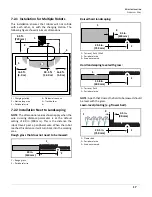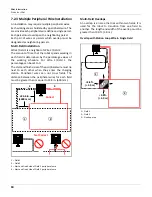
20
W
IRE
I
NSTALLATION
P
ERIPHERAL
W
IRE
If the length of the lane is less than 49.2 ft. (15 m), then
the minimum distance between the peripheral wire
must be greater than 32.8 ft. (10 m).
7.2.6 Islands
Create an island when an obstacle is more than:
•
16.5 ft. (5.0 m) from the peripheral wire
•
49.0 (15.0 m) from the charging station
•
16.5 ft. (5.0 m) from another island or
pseudo-island
7.2.7 Pseudo-Islands
If a pseudo-island is created, the robot will approach
the obstacle, and then maneuver around it.
Create a pseudo-island when an obstacle is less than:
•
16.5 ft. (5.0 m) from the peripheral wire
•
49.0 ft. (15.0 m) from the charging station
•
16.5 ft. (5.0 m) from another island or
pseudo-island
Peripheral wire installation requirements for a
pseudo-island require:
•
a counterclockwise installation direction around
an object
•
a fixed distance of 16.0 - 24.0 in. (400 - 600 mm)
between the approach and return sides
•
do not cross or twist the approach and return
side of the peripheral wire
7.2.8 Obstacles
Obstacles are objects that the robot must avoid. Exam-
ples are:
•
trees, flower beds
•
swing sets, climbing frames, trampolines
•
sidewalks, walking paths, terraces
•
ponds, swimming pools
On a golf course installation, obstacles include:
•
distance markers and flags
•
Target ball nets
•
bunkers
•
water hazards
The sonar sensors on the robot detect certain obsta-
cles. Other obstacles require the installation of an
island or a pseudo-island.
1 – Obstacle
2 – Direction to install peripheral wire (and movement of robot)
3 – Peripheral wire
4 – Fixed distance to secure peripheral wire
x x x x
3
2
4
1
4.0 in.
(100 mm)
1 – Obstacle
2 – Direction to install peripheral wire (and movement of robot)
3 – Peripheral wire
4 – Fixed distance between approach and return sides
4
2
1
3
16.0 - 24.0 in.
(400 - 600 mm)
















































